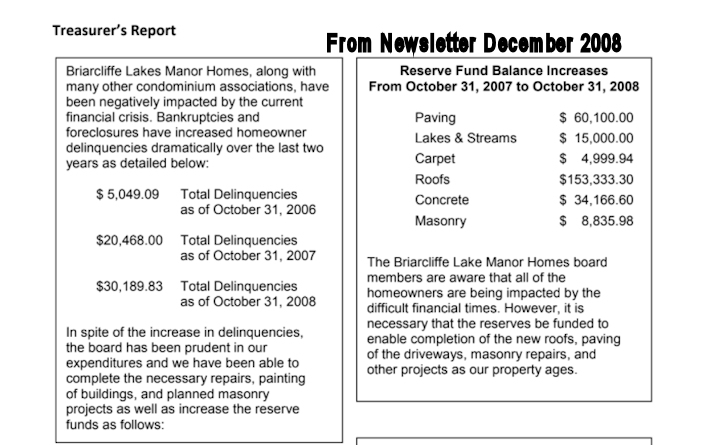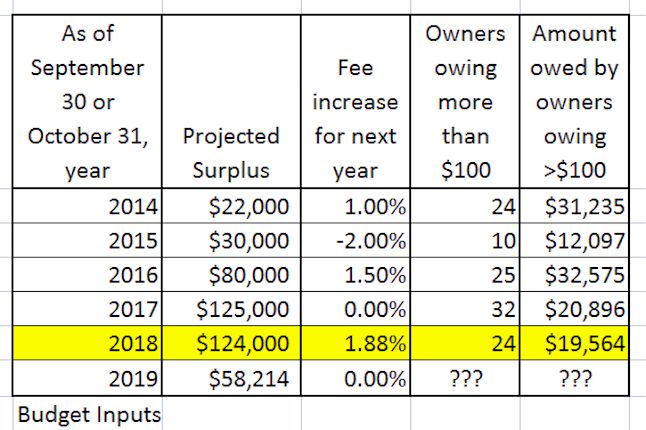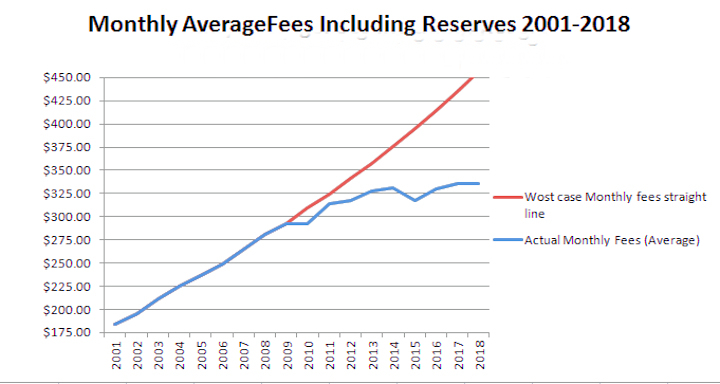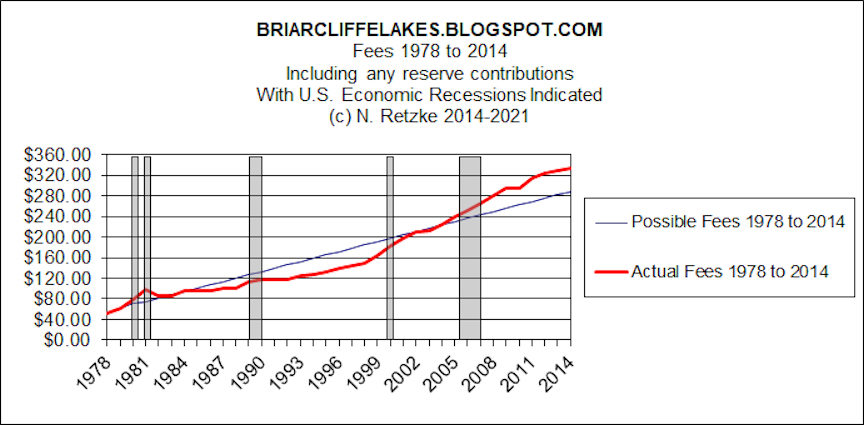First, this post is neither a recommendation nor is it an endorsement. I have no financial stake in the following company nor do I own stock, etc.
A company called "Blue Star Energy Solutions" is advertising electrical energy at a rate competitive with ComEd, my current provider and probably yours. There are several plans available and one include "renewable American energy" at a competitive rate.
Blue Star says this:
Select Energy Plan
With BlueStar Energy you have a choice between renewable American energy at a lower price than you are paying now. An easy and affordable way to become part of the solution to the climate and energy crisis our country faces. Or, choose traditional energy for a discount. The choice is yours.
For a link, click here:
http://bluestarenergy.com/
I suggest you do your own homework and then decide which is better for you.

Above: Intermittently, for a time, boards informed owners of association finances
Newsletter 2008 excerpt is an example of earlier board willingness to communicate with owners.
The boards of 2019-2021 prefer not to do so.
https://tinyurl.com/BLMH2021
Life and observations in a HOA in the Briarcliffe Subdivision of Wheaton Illinois
Best if viewed on a PC
"Briarcliffe Lakes Manor Homes" and "Briarcliffe Lakes Homeowners Association"
Updated Surplus Numbers

Updated Surplus Numbers: Actual surplus 2018 per audit was $85,163.
Boards 2011-2018 implemented policies and procedures with specific goals:
stabilize owner fees, achieve maintenance objectives and achieve annual budget surpluses.
Any surplus was retained by the association.
The board elected in fall 2018 decided to increase owner fees, even in view of a large potential surplus
Average fees prior to 2019

Average fees per owner prior to 2019:
RED indicates the consequences had boards continued the fee policies prior to 2010,
BLUE indicates actual fees. These moderated when better policies and financial controls were put in place by boards
Better budgeting could have resulted in lower fees

Better budgeting could have resulted in lower fees:
RED line = actual fees enacted by boards,
BLUE line = alternate, fees, ultimately lower with same association income lower had
boards used better financial controls and focused on long term fee stability
Saturday, July 31, 2010
Tuesday, July 20, 2010
"Wild Gardens" or "Critter Habitats"?
I spoke briefly with a unit owner on June 28th during a fly-by of Wheaton. This unit owner was fairly excited and confused because it had come to their attention that the board is considering new "wild gardens" here at BLMH. The confusion is caused by the fact that the current landscaping is formal in nature, which is quite apparent. They were also confused because they didn't understand the lack of financial consistency. It will take money to create these new gardens. Where will it come from? We used to have an expression in my business "we can do anything, all it takes is time and money". During the board meetings I have attended, the Landscaping Director has discussed the idea of a "Garden Club" in which unit owners could participate in some aspects of maintaining or improving the grounds at BLMH. It has been repeatedly pointed out by past LDs and management that we have a professional landscaper which is not a gardener.
After the discussions, I now hear that there are residents who are pressing for private gardens. The LD was promoting resident participation for the purpose of handling some of the deficiencies here. However, this seems to have been turned into a conversation based upon "what's in it for me" by some of the owners. Perhaps the term "gardens" was the trigger. There is a lot of pent up demand by our retirees, some of whom probably want something to do besides walk the dog. Having a nice garden would certainly be a great pastime. No one has yet discussed how the half of the owners who live on the second floor would participate. This also has a potential to extend the "ownership" of first floor unit owners into the grounds, as they literally stake out their turf and wall in "their" private gardens. No one on the board has discussed these issues, at least while I have been present.
I would like to see some sustainability in the landscaping. Adding ground cover such as pachysandra (formally known as "pachysandra terminalis") is a great way to reduce mulching and related costs. I know because I have used this in past homes and it was an excellent and hardy ground cover with pleasant springtime blooms. It prefers moderate to deep shade and moist, but drained soil. Just the thing for some of those dark, shady areas unit owners are always complaining about and in which grass will not grow.
We already have some pachysandra here at BLMH and it has proven to be hardy and effective.
Ornamental grasses could also be used. These are hardy and are inexpensive.
The grasses and pachysandra require little or no maintenance. That is, no mowing, mulching, special feed application, etc. That means, reduced costs to the association.
Extensive use of tall grasses could provide ground cover for critters, but most are dense and if applied in smaller areas, that should not be a problem any greater than that caused by our current landscaping scheme.
Comments, Corrections, Omissions, References
================================
I noticed that the daffodils planted at the entrances have been cut back. I'm not certain of why this was done. However, it is common knowledge that the daffodil bulb renews itself through its foliage. The bottom line: after flowering, the foliage must be allowed to grow and mature and die back. Initially the foliage is a nice green, then as the growing season continues it elongates and then becomes yellow and finally turns brown, falls over and dries up. According to experts, "This process is critical for the bulb’s ongoing health and blooming ability."
I realize that the browning and "dying" foliage may be ugly. I suppose that is why it was trimmed. It will be interesting to see if the many daffodils that were planted, return next year. If not, we have wasted these wonderful, perennial plants.
Personally, I always grew daylillies (known formally as "hemerocallis"). The varieties on my property were staggered and intermingled. By doing so I was able to achieve long periods of blooms, commencing in mid June and lasting into August because various bulbs have different growing and blooming rates. The daylillies will, over time, fan out. So as the years went by they became denser and the beds larger. I then had the pleasant task of thinning them slightly. It's always pleasant to have too many beautiful, flowering plants!
Daffodils are nice, but last only a few weeks in the spring, and do have that habit of browning out as the summer progresses.
One cautionary note. It is my understanding that the blooms of daffodils and daylillies are not to be eaten by house cats!
After the discussions, I now hear that there are residents who are pressing for private gardens. The LD was promoting resident participation for the purpose of handling some of the deficiencies here. However, this seems to have been turned into a conversation based upon "what's in it for me" by some of the owners. Perhaps the term "gardens" was the trigger. There is a lot of pent up demand by our retirees, some of whom probably want something to do besides walk the dog. Having a nice garden would certainly be a great pastime. No one has yet discussed how the half of the owners who live on the second floor would participate. This also has a potential to extend the "ownership" of first floor unit owners into the grounds, as they literally stake out their turf and wall in "their" private gardens. No one on the board has discussed these issues, at least while I have been present.
I would like to see some sustainability in the landscaping. Adding ground cover such as pachysandra (formally known as "pachysandra terminalis") is a great way to reduce mulching and related costs. I know because I have used this in past homes and it was an excellent and hardy ground cover with pleasant springtime blooms. It prefers moderate to deep shade and moist, but drained soil. Just the thing for some of those dark, shady areas unit owners are always complaining about and in which grass will not grow.
We already have some pachysandra here at BLMH and it has proven to be hardy and effective.
Ornamental grasses could also be used. These are hardy and are inexpensive.
The grasses and pachysandra require little or no maintenance. That is, no mowing, mulching, special feed application, etc. That means, reduced costs to the association.
Extensive use of tall grasses could provide ground cover for critters, but most are dense and if applied in smaller areas, that should not be a problem any greater than that caused by our current landscaping scheme.
Comments, Corrections, Omissions, References
================================
I noticed that the daffodils planted at the entrances have been cut back. I'm not certain of why this was done. However, it is common knowledge that the daffodil bulb renews itself through its foliage. The bottom line: after flowering, the foliage must be allowed to grow and mature and die back. Initially the foliage is a nice green, then as the growing season continues it elongates and then becomes yellow and finally turns brown, falls over and dries up. According to experts, "This process is critical for the bulb’s ongoing health and blooming ability."
I realize that the browning and "dying" foliage may be ugly. I suppose that is why it was trimmed. It will be interesting to see if the many daffodils that were planted, return next year. If not, we have wasted these wonderful, perennial plants.
Personally, I always grew daylillies (known formally as "hemerocallis"). The varieties on my property were staggered and intermingled. By doing so I was able to achieve long periods of blooms, commencing in mid June and lasting into August because various bulbs have different growing and blooming rates. The daylillies will, over time, fan out. So as the years went by they became denser and the beds larger. I then had the pleasant task of thinning them slightly. It's always pleasant to have too many beautiful, flowering plants!
Daffodils are nice, but last only a few weeks in the spring, and do have that habit of browning out as the summer progresses.
One cautionary note. It is my understanding that the blooms of daffodils and daylillies are not to be eaten by house cats!
Labels:
Wild Gardens,
Wildlife
Subscribe to:
Posts (Atom)